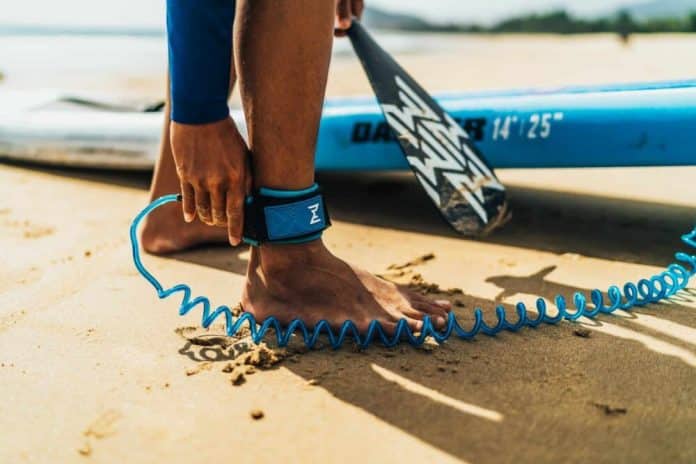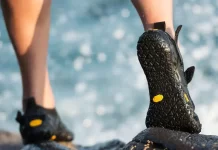In the stand-up paddleboarding (SUP) world, there’s a small yet essential accessory that often goes unnoticed but plays a crucial role in ensuring our safety and enjoyment on the water – the SUP leash.
This seemingly simple device connects us to our board, preventing it from floating away and keeping us tethered in case of an unexpected fall. This article will explore the fascinating mechanics behind how a SUP leash works and uncover why it is an indispensable tool for all paddleboard enthusiasts.
What is a SUP Leash?
Definition
A SUP leash, or a stand-up paddleboard leash, is an essential safety device paddlers use to ensure their board remains attached to them in the event of a fall or strong currents. It consists of a durable, flexible cord, typically made of urethane, and is attached to both the paddleboard and the paddler’s body.
Components of a SUP Leash
A SUP leash comprises several components that keep the paddleboard tethered to the paddler. These components include the cord, typically coiled or straight, the ankle or calf cuff that secures the paddler’s body, and the attachment point that connects the leash to the board.
How Does a SUP Leash Work?
Attachment to the Paddleboard
The attachment point of the SUP leash to the paddleboard is a crucial element in its functionality. Most SUP boards have a small plastic plug near the tail as the attachment point. The leash is typically secured to this plug using a quick-release mechanism or a knot.
Attachment to the Paddler
Using a cuff, the other end of the SUP leash is attached to the paddler’s ankle or calf. The cuff is designed to securely fasten around the paddler’s leg, allowing them to move freely without the risk of the leash slipping off. The leash is usually adjustable, allowing paddlers of different sizes to find a comfortable fit.
Safety Benefits of Using a SUP Leash
Preventing Board Drift
One of the critical safety benefits of using a SUP leash is preventing board drift. In windy or current solid conditions, a paddleboard can easily drift away from the paddler if they fall or become separated from their board. Using a leash, the paddleboard remains tethered to the paddler, making it much easier to retrieve and reducing the risk of being stranded in open water.
Minimizing Injuries
Another crucial safety benefit of using a SUP leash is minimizing injuries. In the event of a fall, the leash prevents the paddleboard from being carried away by the current or wind, reducing the chance of collision with other objects or individuals. Additionally, it helps prevent the paddleboard from washing onto shore, potentially injuring beachgoers or damaging property.
Assisting in Self-Rescue
An adequately attached SUP leash can also greatly assist in self-rescue situations. If paddlers fall off their board, particularly in rough or choppy waters, they can quickly retrieve it by tugging on the leash. This makes it easier to remount the board and continue paddling, avoiding potential exhaustion or danger that may arise from swimming to retrieve a drifting or distant board.
Types of SUP Leashes
Coiled SUP Leash
The coiled SUP leash is popular among paddlers, especially those who predominantly paddle in flatwater conditions. The coiled design helps to minimize entanglement, as the leash naturally retracts when not under tension. This type of leash is particularly convenient for paddlers who frequent areas with seaweed or other floating debris, as the coiling reduces the likelihood of snagging.
Straight SUP Leash
The straight SUP leash is another commonly used leash option. It consists of a straight, non-coiled cord that connects the paddleboard to the paddler. This leash is commonly used in surf conditions, allowing more unrestrained movement and easier maneuverability.
Ankle Leash vs. Calf Leash
When choosing a leash, paddlers also have the option of ankle leashes or calf leashes. Ankle leashes are the most popular choice, as they offer a secure attachment to the lower leg and provide greater freedom of movement. Calf leashes, on the other hand, offer a bit more stability and are preferred by paddlers who prioritize a snugger fit.
Factors to Consider When Choosing a SUP Leash
Board Length and Wave Conditions
The length and type of waves you plan to paddle in should be considered when choosing a SUP leash. For longer boards and more giant waves, a longer leash is recommended to ensure the board remains within reach in the event of a fall. Shorter boards and smaller waves typically require a shorter leash to prevent excessive slack and potential tangles.
Leash Length and Thickness
A SUP leash’s length and thickness should also be considered. Longer leashes provide more freedom of movement but can increase the risk of entanglement. Thicker leashes, on the other hand, offer durability and strength but may cause more drag in the water. Balancing these factors is essential to find a leash that suits your needs and preferences.
Attachment Type
Paddleboards may have various attachment methods, such as a plug or a D-ring. When choosing a SUP leash, ensure the attachment mechanism matches your board’s attachment point. Additionally, consider the ease of attaching and detaching the leash and the security of the connection to prevent accidental detachment.
Proper Attachment and Use of a SUP Leash
Attaching the Leash to the Paddleboard
Locate the attachment point near the board’s tail to attach a SUP leash to the paddleboard properly. If a plug is present, insert the attachment end of the leash into the plug and secure it using the designated method. If the attachment mechanism is a D-ring, loosen the leash and secure the ring.
Securing the Leash to the Paddler
Once the leash is securely attached to the paddleboard, fasten the cuff around your ankle or calf, depending on your preference. Ensure the cuff is snug but not overly tight, allowing for comfortable movement. Double-check that the leash is not twisted or tangled before entering the water.
Common SUP Leash Mistakes to Avoid
Using the Wrong Leash for Conditions
One of the most common mistakes paddlers make is using the wrong type of leash for the conditions they will be paddling in. Using a coiled leash in surf conditions or a straight leash in water can hinder paddling performance and compromise safety. It is essential to choose a leash that is appropriate for the specific environment and wave conditions.
Improper Attachment or Securement
Improper attachment or securement of the SUP leash can lead to equipment failure or detachment during paddling. It is crucial to follow the manufacturer’s instructions and ensure a secure connection between the leash and the paddleboard. Regularly check the leash attachment before every paddle to minimize the risk of detachment.
Neglecting Maintenance
Regular maintenance of a SUP leash is often overlooked but is vital for its longevity and reliability. After each use, rinse the leash with fresh water to remove salt, sand, or debris that may cause corrosion or damage. Additionally, inspect the leash regularly for signs of wear and tear, such as fraying or cracks, and replace it as needed to maintain optimal safety.
Considerations for Advanced Paddlers
Leashless Paddling
Advanced paddlers may opt for leashless paddling in certain situations. Leashless paddling refers to paddling without a leash attached, providing greater freedom of movement and reducing the risk of entanglement. However, this should only be done in controlled environments, away from other water users, and with confidence in your ability to handle your board safely.
Waist Leashes vs. Ankle Leashes
Waist leashes are an alternative to ankle leashes for advanced paddlers. These leashes are worn around the waist, allowing for even more freedom of movement and preventing the leash from interfering with leg movement. Waist leashes are particularly popular among paddle surfers and those participating in races or other high-performance activities.
Importance of Regularly Checking and Replacing a SUP Leash
Wear and Tear
A SUP leash is subject to wear and tear over time, especially if exposed to rough conditions or extensive use. Regularly check the leash for signs of wear, such as fraying, stretching, or damage to the cuff, cord, or attachment mechanism. Replacing the leash at the first signs of significant wear is essential to maintain optimal safety.
UV Damage
Continuous exposure to the sun’s harmful UV rays can deteriorate the materials of a SUP leash over time. UV damage can weaken the leash’s strength and compromise its performance. Store your leash out of direct sunlight when not in use and replace it if you notice signs of UV damage, such as fading or brittleness.
Saltwater Exposure
Saltwater is corrosive and can accelerate the deterioration of a SUP leash if not correctly cared for. After each use, rinse the leash with fresh water to remove salt and other contaminants. Regularly inspect the leash for signs of corrosion or weakening due to saltwater exposure and replace it if necessary.
Conclusion
A SUP leash is an indispensable tool for paddlers of all skill levels. It provides crucial safety benefits such as preventing board drift, minimizing injuries, and assisting self-rescue.
When choosing a SUP leash, consider board length, wave conditions, leash length, thickness, and attachment type. Proper attachment and use of a SUP leash are essential to ensure its effectiveness.
Avoid common mistakes such as using the wrong leash for conditions, improper attachment, and neglecting maintenance. Advanced paddlers may explore leashless paddling or waist leashes as alternatives. Regularly check and replace a SUP leash to maintain its integrity, as wear and tear, UV damage, and saltwater exposure can compromise its safety.
By understanding how a SUP leash works and recognizing its importance, paddlers can enhance their safety and enjoy their paddleboarding adventures with peace of mind.





































